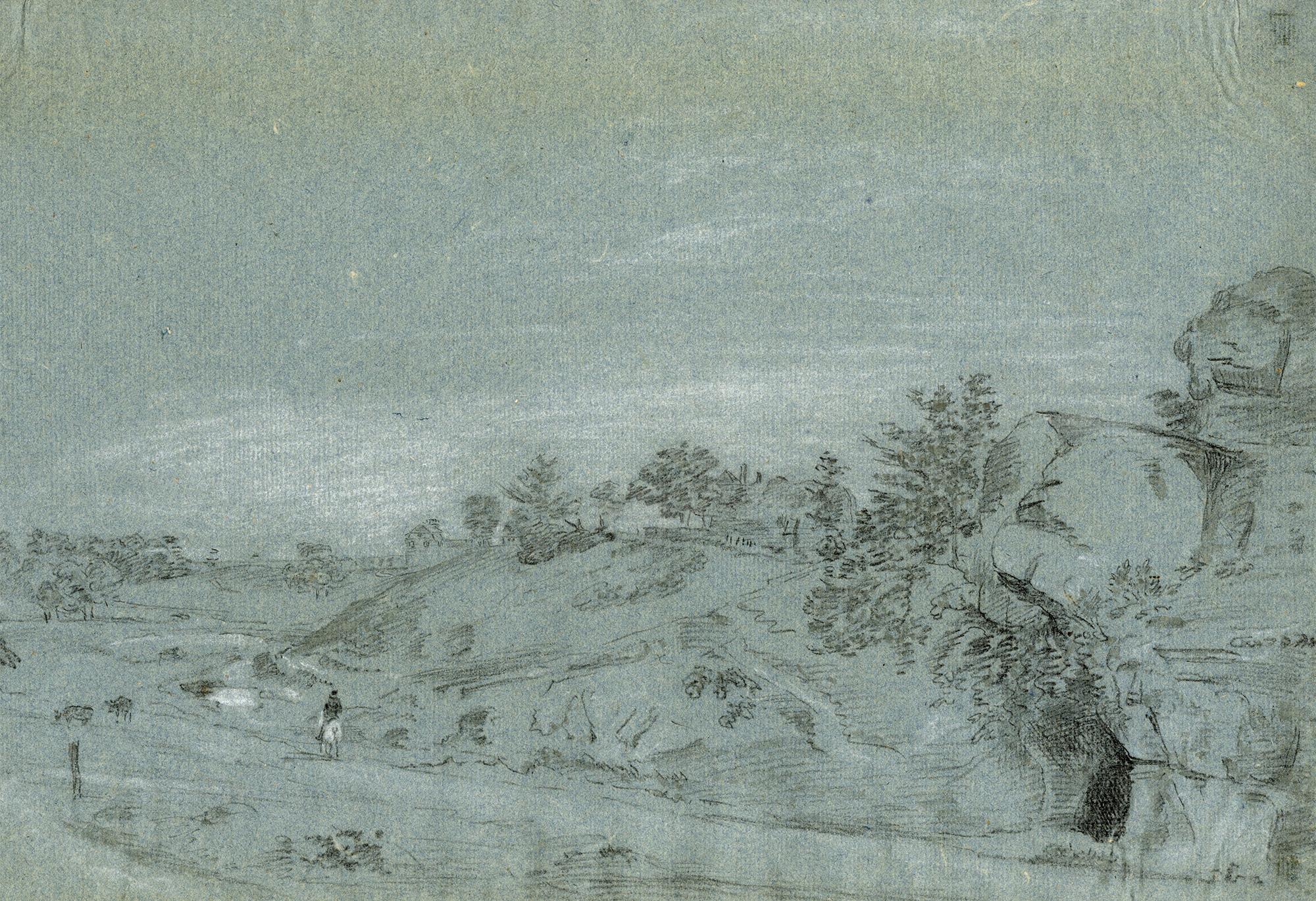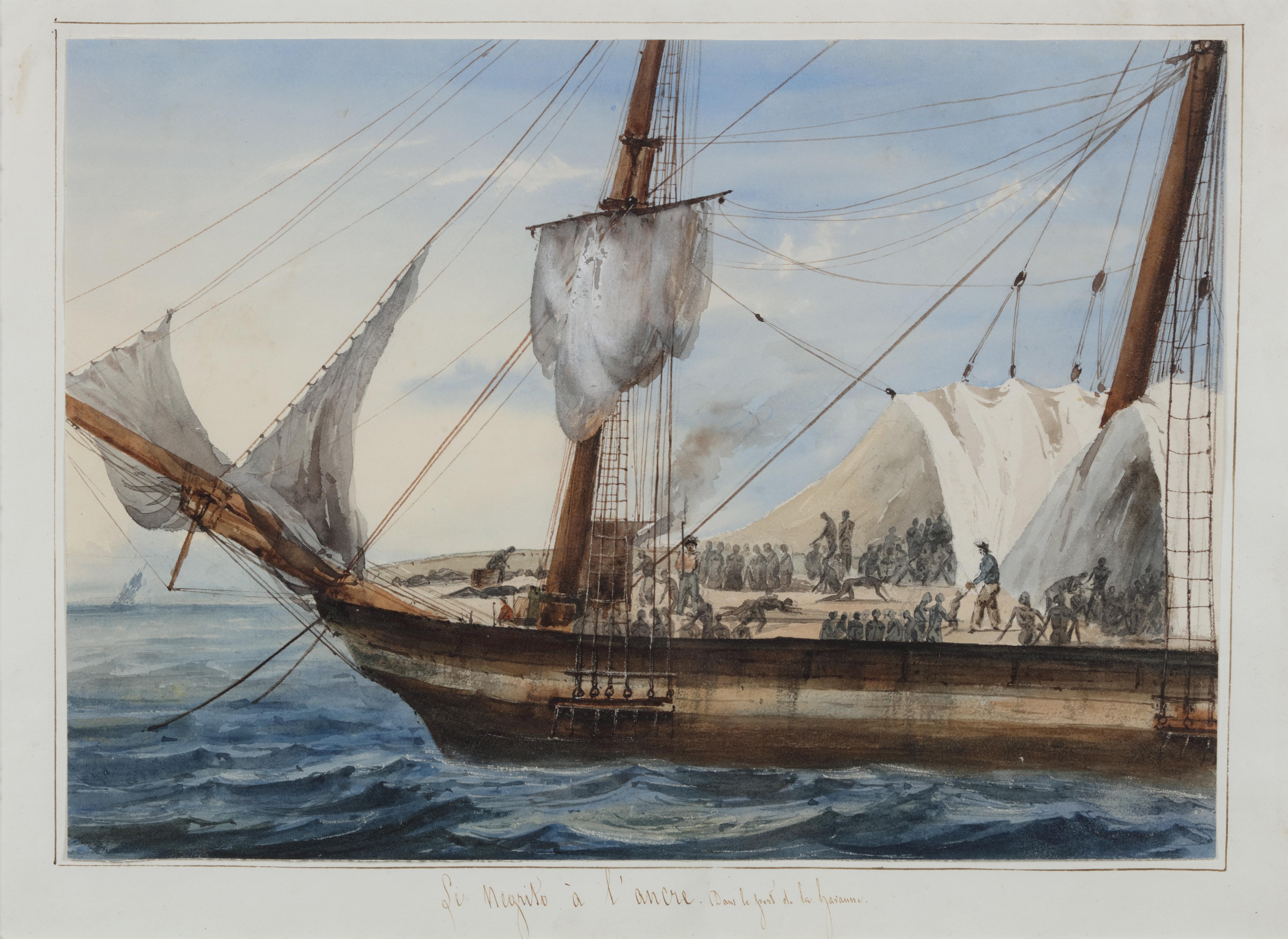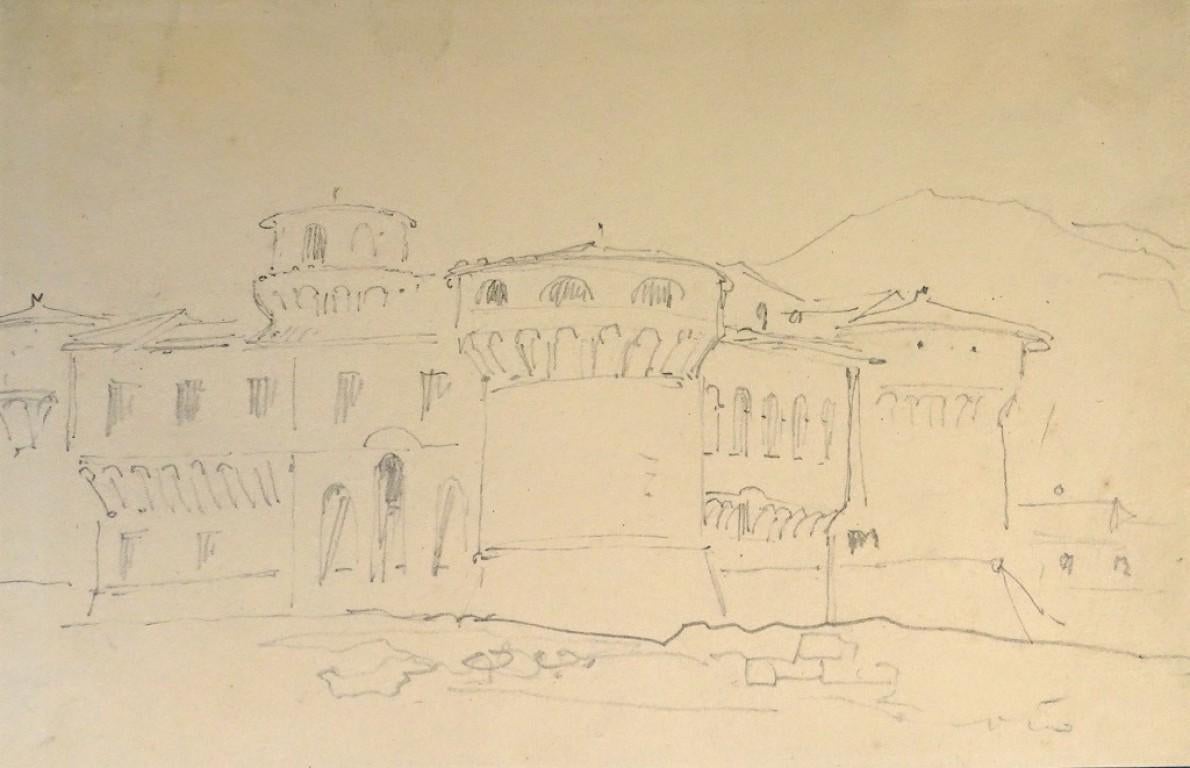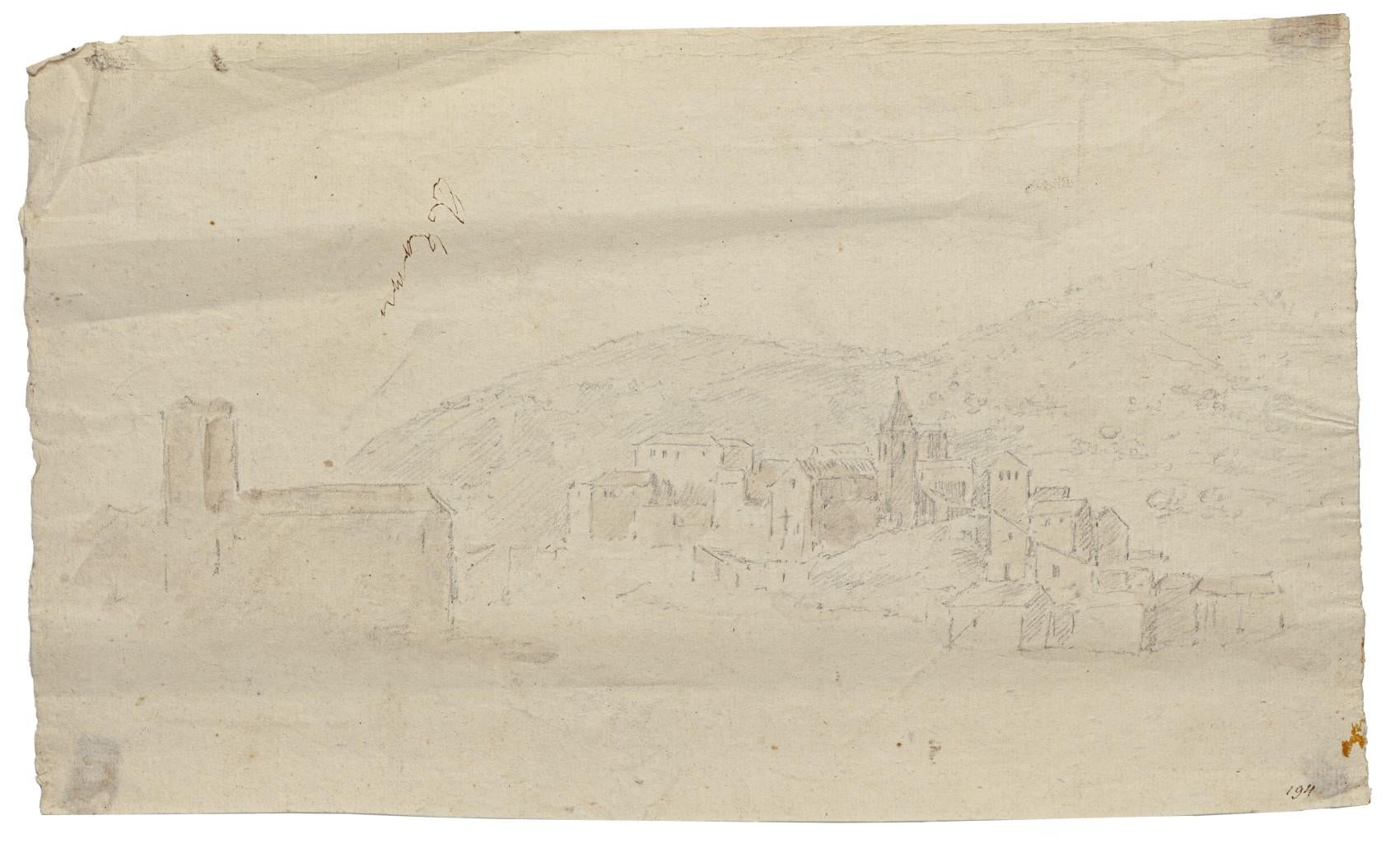Items Similar to Study for « The Chinese Masquerade » by Jean-Baptiste Pierre (1714 - 1789)
Want more images or videos?
Request additional images or videos from the seller
1 of 10
Jean-Baptiste PierreStudy for « The Chinese Masquerade » by Jean-Baptiste Pierre (1714 - 1789)1735
1735
About the Item
Arriving in Rome in June 1735 as a resident at the Royal Academy, Pierre was unable to attend the Winter Carnival festivities of 1735, which he nevertheless immortalised in an engraving made shortly after his arrival. This drawing, probably a preparatory one, shows the full extent of his talent and is a rare testimony to his early works, since it is probably the oldest surviving drawing by the artist.
1. The sojourn in Rome, a key stage in the life of Jean-Baptiste Marie Pierre
Jean-Baptiste Marie Pierre was born in Paris on March 6, 1714 into a wealthy family of goldsmiths and jewellers. His father Jean Pierre was elected alderman in 1743, which ennobled him. This family affluence gave him access to academic studies with a tutor. Pierre became a pupil of the painter Nicolas Bertin (1668-1736) and took courses at the Royal Academy of Painting and Sculpture where he became friends with the engraver Charles-Nicolas Cochin le Fils (1715 - 1790). This friendship also led him to the workshop of Cochin le Père (1688 - 1754) from whom he probably learned engraving and who made him aware of Watteau's art.
In 1734, he was awarded the Academy’s grand prize for painting for his work Sanson, whose hair was cut by Delilah (the present whereabouts of which is unknown). He was then allowed to join the Académie de France in Rome, under the direction of the painter Nicolas Vleughels (1688-1737). He stayed in Rome from June 1735 to June 1740.
Back in Paris in 1740, his success meant that in 1752, he became First Painter to the Duke of Orleans for whom he painted several ceilings at the Palais-Royal and the Château de Saint-Cloud. Between 1752 and 1757 he also painted two domes for the church of Saint-Roch in Paris. He became First Painter to the King in 1770, following François Boucher, and exerted a determining influence on the art and artists of his time. He reserved his talents as a painter exclusively for royal commissions and died on 15 May 1789, on the eve of the Revolution.
2. The Chinese Masquerade, one of his first engravings
Arriving in Rome at the end of June 1735, shortly after his arrival Pierre engraved La Mascarade Chinoise faite à Rome le Carnaval de l'année MDCCXXXV par Messieurs les Pensionnaires du Roy de France en son Académie des arts, which he dedicated to the Duke of Saint-Aignan, French Ambassador in Rome from 1732 to 1740. Perhaps this was a commission from the Duke, who was aware of Pierre's engraving talents, or a way for the young artist to secure his protection? The engraving shows the moment when the chariot of residents passes in front of the Antonine column in the Piazza Colonna, almost opposite the Palazzo Mancini, the seat of the Académie de France in Rome.
Pierre was probably inspired by the memories of his new comrades at the Académie de France, or by drawings they would have made during the Carnival. It is also likely that he was able to actually see and draw for himself the float used for the parade, which was probably still in existence when he arrived in Rome a few months later.
3. Similarities and differences
The engraving is slightly smaller than our drawing (30.5 x 42.5 cm compared to 34.4 x 51 cm). It obviously shows the design inverted in relation to the drawing from which the plate used for printing was made. It is interesting to see both the drawing and part of the engraving side by side corresponding to the (inverted) float shown on the drawing. This comparison shows that, despite some differences, the two artworks are very similar, both in their general conception and in many ornamental details.
The drawing only shows the float without the urban landscape in the background. The general composition of the two artworks is very similar: a chariot drawn by two horses moves forward, accompanied by several figures also dressed as Chinese who walk beside it and at the back of the float. In the chariot are the residents and two of their friends, all dressed as Chinese, sitting three by three in five rows. At the back of the float sits a figure with a sophisticated turban, accompanied on his right by a woman also dressed in Chinese style and on his left by a young man wearing a wig, who seems to be pointing at the Academy building. Another woman is also present in the second-to-last row, but all the other passengers in the float are male. They sport long fake moustaches under their conical hats.
At the very front, just behind the coachman, a figure also dressed in Chinese style, carries a sign. The main differences between the two works concern the characters seated in the first three rows, some of whom were blowing horns in the drawing, and the pedestrians. The first of the pedestrians in the engraving is blowing a trumpet, whereas in the drawing he is carrying a panel decorated with ideograms. The second has a trumpet under his arm, which replaces the standard he had in the drawing. In the engraving these vertical elements (standard, sceptre) have been removed and the attitudes of the characters seated in the chariot simplified for better legibility and greater fluidity in the movement.
It is difficult to compare this drawing with any other drawings by Pierre from his early Roman sojourn or his Parisian apprenticeship, as no other drawings from this period have been passed on. The group at the top of the chariot under the palanquin has been executed with great delicacy and the clear similarities between the drawing and the engraving give us every reason to think that we have here the work of the same artist.
This drawing is presented in a large carved and gilded wooden frame from the Louis XVI period, whose rigor contrasts with the extreme fantasy of the drawing.
Main bibliographic reference:
Nicolas Lesur - Olivier Aaron - Jean-Baptiste Marie Pierre 1714-1789 Premier Peintre du Roi - Arthena 2009
- Creator:Jean-Baptiste Pierre (1714 - 1789, French)
- Creation Year:1735
- Dimensions:Height: 13.55 in (34.4 cm)Width: 20.08 in (51 cm)
- Medium:
- Movement & Style:
- Period:1730-1739
- Condition:34.4 x 51 cm (59 x 71.2 cm framed) The engraving image is for illustration purpose only and is not sold with this drawing Framed in a Louis XVI period frame (regilded).
- Gallery Location:PARIS, FR
- Reference Number:1stDibs: LU156828970112
About the Seller
5.0
Vetted Seller
These experienced sellers undergo a comprehensive evaluation by our team of in-house experts.
Established in 2020
1stDibs seller since 2021
8 sales on 1stDibs
Typical response time: 2 hours
- ShippingRetrieving quote...Ships From: PARIS, France
- Return PolicyA return for this item may be initiated within 3 days of delivery.
More From This SellerView All
- A landscape drawing by Claude Lorrain, with a preliminary sketch on the versoBy Claude LorrainLocated in PARIS, FRThis study presents a typical Roman countryside landscape: an ancient mausoleum in front of which a cart is passing by followed by two peasants. If the technique (a pen drawing on graphite lines, completed with a wash of brown and grey inks) and the signature inevitably evoke the art of Lorrain, we find on the verso of this drawing additional evidences that lead us to consider this unpublished drawing as a work by the master. The motif of the mausoleum has been taken up in pen on the verso in a technique that can be found in several other drawings by Lorrain. There is also a study of three characters, which can be considered as preparatory to Lorrain’s painting entitled The Port of Ostia with the Embarkation of Saint Paula, leading us to claim this attribution with a dating of around 1629. 1. Claude Lorrain or the perfection of classical landscape in Rome in the 17th century Claude Gellée was born in 1600 in Chamagne in Lorraine. Orphaned at the age of twelve, he spent a year with his brother in Freiburg, where the latter was a woodcarver. Claude Gellée then probably arrived in Rome in 1613, where he joined the workshop of Agostino Tassi (1580 - 1644) in 1617. Between 1619 and 1620 he studied for two years in Naples in the workshop of Goffredi Wals (who was himself a former pupil of Tassi). In 1625 he returned to Lorraine for two years where he worked alongside Claude Deruet. He then returned to Rome, a city he never left for the rest of his life (except for short trips to the surrounding countryside). From 1627 to 1650 he lived in Via Margutta. From 1635 onwards he became a renowned painter and commissions started to pour in. Considered during his lifetime as the most accomplished of the classical landscape painters, his reputation never faded. Between 1629 and 1635 Le Lorrain often went to the Roman countryside to draw with his friend Joachim von Sandrart (1606 - 1686). He became a member of the Academy of Saint Luke in 1633, while being closely acquainted with the Bentvueghels, this guild which brought together the young Nordic painters active in Rome. In 1643 he joined the Congregation of the Virtuosi. In 1650 he moved to Via Paolina where he lived until his death. Little is known of his intimate life. He seems to have had a daughter, Agnes, from an ancillary love affair. In 1657/ 1658 she moved in with him. Stricken with gout in 1663, he died in 1682. 2. Description of the drawing; the technique of nature studies Two peasants are walking behind a horse-drawn cart on a road that winds through ancient tombs. While a rectangular tomb with a columned facade can be seen in the distance, the cart passes an important ancient building. It has a circular shape and its partially ruined façade is decorated with columns. The start of a second floor can...Category
1660s Old Masters Landscape Drawings and Watercolors
MaterialsInk, Pen, Graphite
- Italian Landscape, a drawing by Louis-Jean Desprez (1743 - 1804)Located in PARIS, FRThis landscape, masterfully executed in pen and wash by Louis-Jean Desprez around 1779, probably represents a view of the Roman countryside. The treatment of the trees is very similar to that of two engravings which Desprez executed in Rome, The Island of Cythera and The Temple of Love. 1. Louis-Jean Desprez, a cosmopolitan life between Italy and Sweden Born in Auxerre in 1743, Louis-Jean Desprez probably began his apprenticeship with the engraver Charles-Nicolas Cochin...Category
1770s Old Masters Landscape Drawings and Watercolors
MaterialsCarbon Pencil, Ink
- Three studies executed in the Pitti Palace in 1761 by Jean-Honoré FragonardBy Jean-Honoré FragonardLocated in PARIS, FRThis brilliant study sheet, of which we present here a counterproof, is a souvenir of Fragonard's return journey from Italy. Between April and September 1761, he accompanied the abbot of Saint-Non on his way back to France. Three studies after the masters taken from the Pitti Palace’s gallery in Florence are gathered on this sheet. Although The Ecstasy of Saint Margaret...Category
1760s Old Masters Figurative Drawings and Watercolors
MaterialsCarbon Pencil
- Portrait of a Lady, Drawing Signed and Dated by Augustin de Saint-AubinBy Augustin de Saint-AubinLocated in PARIS, FRThis drawing full of freshness presents us with the profile of an elegant lady, drawn by Augustin de Saint-Aubin on a beautiful summer day in 1776, during the early months of Louis X...Category
1770s Old Masters Portrait Drawings and Watercolors
MaterialsPastel, Pencil
- The Arab Butcher, a preparatory drawing by Gustave Guillaumet (1840 - 1887)Located in PARIS, FRThis intensely expressive figure is a preparatory study for "Arab Market on the Tocria Plain", a painting exhibited at the 1865 Salon and now in the Musée des Beaux-Arts in Lille. 1...Category
1860s Old Masters Figurative Drawings and Watercolors
MaterialsChalk, Carbon Pencil
- Landscape with Trees and a Fisherman walking, a drawing by Jan Van GoyenBy Jan Josefsz Van GoyenLocated in PARIS, FRNo Dutch draughtsman ever captured the atmosphere of the rural countryside of Holland with the same atmospheric and engaging simplicity that Van Goyen achieved in drawings such as this. Indeed, his landscapes were seminal in the development of the genre. The present sketch conveys a striking sense of movement within the natural landscape, conveyed by the deftly applied strokes of chalk, from which the artist’s hand can be sensed. The composition is characteristic of his work, with the low horizon affording significance to the broad sky and the soaring birds within. This feeling of windswept motion powerfully evokes the expansive Dutch farmland with which he was evidently preoccupied. 1. Jan van Goyen...Category
1650s Old Masters Landscape Drawings and Watercolors
MaterialsChalk, Ink, Laid Paper
You May Also Like
- At Tunbridge WellBy Agostino AglioLocated in Middletown, NYBlack crayon and graphite with white heightening on blue handmade laid paper. Adhered at all four corners to a period support, on which the title and an illegible date (perhaps 1815) appear to be written in the artist's hand. ________ Aglio was born in Cremona is 1777 and his artistic talent was recognized early in his life. He was promised a place at the University in Milan by the Holy Roman Emperor, however, his formal education was upended before it even began by the invasion of Italy and Austria by Napoleon. Aglio joined the war effort and fought in a series of major battles near Venice before becoming seriously ill. At the age of about 23 he was released from duty, and traveled to Rome to focus on his health, and landscape painting. In Rome, Aglio studied with the renowned artist Campovecchio. At the invitation of well known British architect William Wilkins (designer of the National Gallery and University College London), Aglio relocated to London in 1803. He made London his permanent home, and married Letitia Clarke in 1805. He enjoyed a lucrative career painting frescoes in the interiors of high society townhouses, country manors, and major London concert halls and theaters. Most notably, Aglio painted multiple official portraits of Queen Victoria...Category
Early 19th Century Old Masters Landscape Drawings and Watercolors
MaterialsHandmade Paper, Laid Paper, Color Pencil, Graphite, Crayon
- Portrait of a Slave Ship: 'Le Negrito à l’ancre. Dans le port de la havanne'Located in Amsterdam, NLFRANÇOIS MATHURIN ADALBERT, BARON DE COURCY (1805-1839) 'Le Negrito à l’ancre. Dans le port de la havanne' Indistinctly signed lower left Titled on the mount Pencil and watercolour, heightened with white, on paper, 24.8 x 34.6 cm Literature: The present watercolour will be illustrated in: - Prof. Manuel Garcia’s projected book on the disease and the slave trade provisionally titled “Fighting the Yellow Demon of Fever: The Struggle against Disease in the Illegal Slave Trade”. - Prof. Micael Zeuske’s forthcoming Global history of slave trade. Exhibited: Mexico City, 1998, Palacio Virreinal, El Barón de Courcy, illustrationes de un viaje, 1831-1833, no. 108 Note: Baron de Courcy was in the Caribbean in late 1832 and early 1833, following his tour of Mexico in 1832, on the last leg of his “Grand Voyage...Category
Mid-19th Century Old Masters Figurative Drawings and Watercolors
MaterialsGouache, Pencil, Paper, Watercolor
- Chateau Fort - 19th Century - Horace Vernet - Drawing - Old MasterBy Émile Jean-Horace VernetLocated in Roma, ITChateau fort is an original pencil drawing on paper by Horace Vernet realized in XIX century. Certified by Paul Proutè. Very good conditions, except for a very little rip on the lef...Category
19th Century Old Masters Figurative Drawings and Watercolors
MaterialsPencil
- Landscape - Watercolor and Pencil by Jan Peter Verdussen - 18th CenturyBy Jan Peeter VerdussenLocated in Roma, ITLandscape is a beautiful dranwing in watercolor and pencil on ivory-colored paper realized by Jan Peter Verdussen. In good condition; only a sma...Category
18th Century Old Masters Landscape Drawings and Watercolors
MaterialsWatercolor, Pencil
- Rome/Tevere - Pencil and Watercolor Drawing - 1781By Jan Peeter VerdussenLocated in Roma, ITRome is a beautiful artwork realized by Jan Peter Verdussen in 1741. In good condition except for some pencil marks and traces of sealing wax on the back and some diffused foxings. ...Category
1780s Old Masters Landscape Drawings and Watercolors
MaterialsWatercolor, Pencil
- Landscape - Drawing by Jan Peter Verdussen - 1745 caBy Jan Peeter VerdussenLocated in Roma, ITLandscape is a beautiful drawing in pencil and watercolor on paper realized by Jan Peter Verdussen in 1745 ca. In good condition, excpet for some foxing on the right. The artwork r...Category
1740s Old Masters Landscape Drawings and Watercolors
MaterialsWatercolor, Pencil





